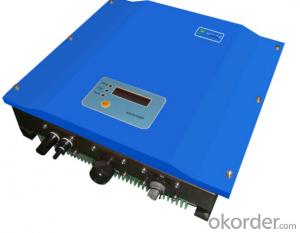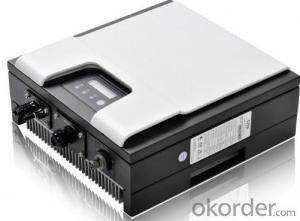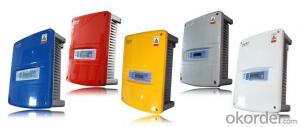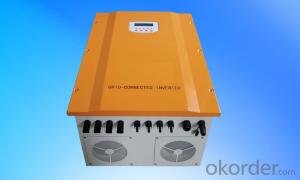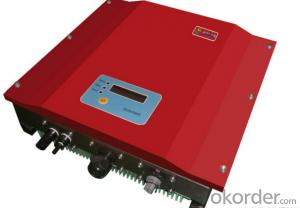IGBT Three Phase 13k Solar Inverter Made in China
- Loading Port:
- Shanghai
- Payment Terms:
- TT OR LC
- Min Order Qty:
- 0 watt
- Supply Capability:
- 10000 watt/month
OKorder Service Pledge
OKorder Financial Service
You Might Also Like
Description of Three Phase 13k Solar Inverter
Solar ac power system consists of solar panels, charge controllers, inverter and battery; Solar energy does not include inverter dc power system. Inverter is a kind of power conversion device, inverter by incentives can be divided into self-excited oscillation inverter and separately excited oscillation inverter.
Features of Three Phase 13k Solar Inverter
Including three series,7 models
Both economical and high effciency
Smaller and lighter, 20Kw-TL weighs only 45kg
External Inductor
LCD screen with four buttons
Ethernet wifi or GPRS cascade data communication technology
User, installer, distrbutor, Omnik headquarter all-round remote control
Meets VDE-AR-N4105,BDEW approval
Built-in lightning protection module as an option
Advantages of Three Phase 13k Solar Inverter
Meets all the needs of medium power three phase inverter
Economy, high reliability and long life circle
Convenient to transport and install
Reducing machine temperature, extends device lifetime
Easy to operate, user friendly
One power station needs only one monitoring equipment
Real-time operation condition accessible, fast fault responding speed
Adjustable active and reactive power
Built-in lighting protection module
Technical Data of Three Phase 13k Solar Inverter
| Type | Omniksol-13k-TL |
| Input(DC) | |
| Max.PV Power | 13500W |
| Max,DC Voltage | 1000V |
| Nominal DC Voltage | 640V |
| Operating MPPT Voltage Range | 250-800V |
| MPPT Voltage Range at Nominal Power | 400-800V |
| Start up DC Voltage | 300V |
| Turn off DC Voltage | 250V |
| Max, DC Current(A/B) | 22A/11A |
| Max, Short Cicuit Current for each MPPT | 25A/15A |
| Number of MPP trackers | 2 |
| Max, Input Power for each MPPT* | 5000W |
| Number of DC Connection | A:3/B:3 |
| DC Connection Type | MC4 connector |
| Output(AC) | |
| Max,AC Apparent Power | 13000VA |
| Nominal AC Power (cos phi = 1) | 13000W |
| Nominal AC Voltage | 3/N/PE;220/380V |
| 3/N/PE;230/400V | |
| 3/N/PE;240/415V | |
| Nominal Grid Frequency | 50Hz/60Hz |
| Max, AC Current | 20.0A |
| Grid Voltage Range** | 185-276V |
| Grid Frequency Range** | 45-55Hz/55-65Hz |
| Power Factor | 0.9 capacitive... 0.9 inductive |
| Total Harmonic Distortion(THD) | <2% |
| Feed in Starting Power | 60W |
| Night time Power Consumption | <1W |
| Standby Consumption | <12W |
| AC Connection Type | Plug-in connertor |
| Efficiency | |
| Max,Efficiency | 98.0% |
| Euro Efficiency | 97.5% |
| MPPT Efficiency | 99.9% |
| Safety and Protection | |
| DC Insulation Monitoring | Yes |
| DC Switch | Optional |
| Residual Current Monitoring Unit (RCMU) | Integrated |
| Grid Monitoring with Anti-islanding | Yes |
| Electricity Fuse Protection | Yes |
| Protection Class | Ⅰ(According to IEC 62103) |
| Overvoltage Category | PV Ⅱ/ Mains Ⅲ(According to IEC 62109-1) |
| Reference Standard | |
| Safety Standard | EN 62109, AS/NZS 3100 |
| EMC Standard | EN 6100-6-1, EN 6100-6-2, EN 6100-6-3 EN 6100-6-4, EN 6100-3-2, EN 6100-3-3 |
| Grid Standard | VDE-AR-N4105. VDE-0126-1-1,G83/1,EN 50438,RD1699,CEI 0-21, AS4777,C10/C11 |
| Physical Structure | |
| Dimensions | 575x650x248mm |
| Weight | 44.5kg |
| Environmental Protection Rating | IP 65 (According to IEC 60529) |
| Cooling Concept | Natural convection |
| Mounting Information | Wall bracket |
| General Data | |
| Operating Temperature Range | -25℃ to +60℃(derating above 45℃) |
| Relative Humidity | 0% to 98%, no condensation |
| Max. Altitude (above sea level) | 2000m |
| Noise Type | <45dB |
| Isolation Type | Transformerless |
| Display | TFT Graphic Display |
| Data Communication | RS485(WiFi, GRPS optional) |
| Computer Communication | RS485(USB) |
| Standard Warranty | 10 Years (5-15 years optional) |
IMages of Three Phase 13k Solar Inverter

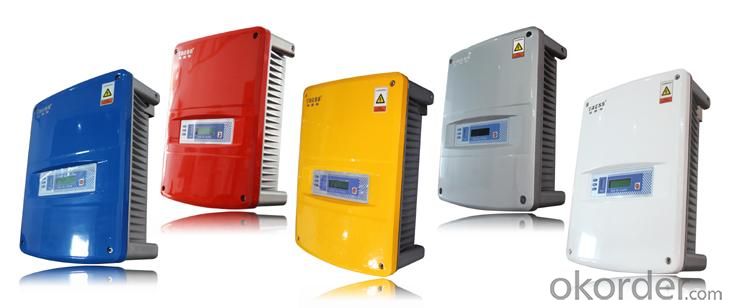
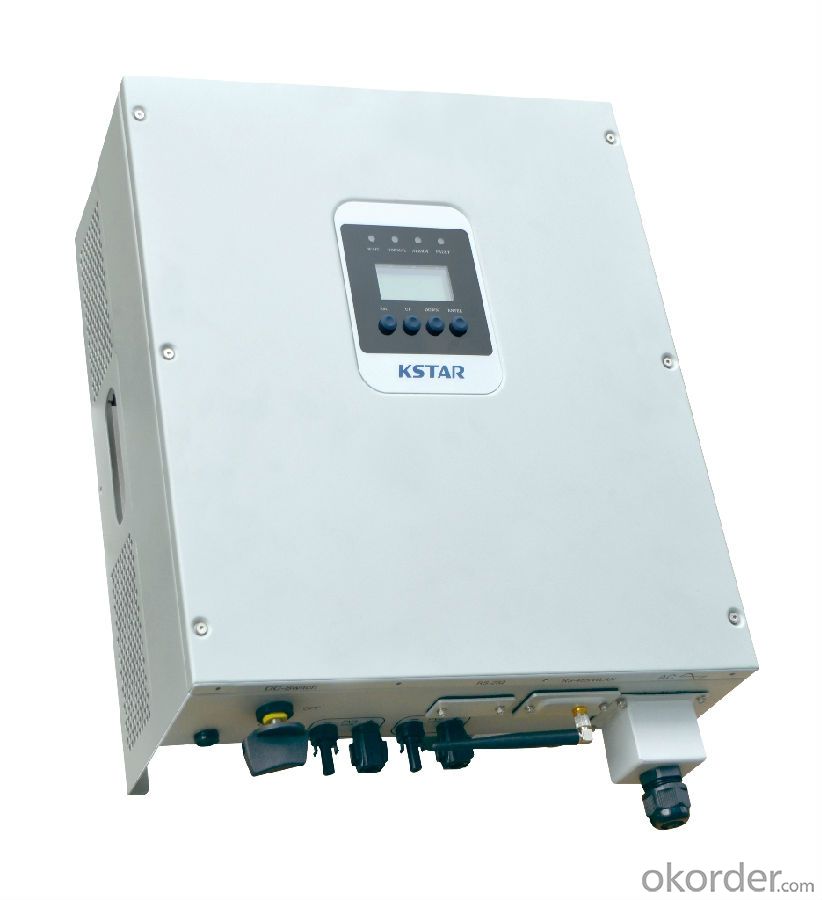
FAQ
Q: Do you have the CE, TUV, UL Certification?
A: We’ve already passed all the tests, and any certificate is available.
Q: Have you ever sold your products to companies in my country?
A: Of course, we have customers in all general PV markets, but I think we should expand our market share along with the market growth.
Q: When did your company set up? You are a new company, how can I believe your quality?
A: We entered into Solar PV industry in 2005, now we have several plants in manufacturing of a-Si and c-Si panels, and our capacity is 220MW per year. Till now we have already passed all the tests by authorized laboratories, e.g. TUV, CE, UL.
Q: Can you help us install the module if we cooperate with you?
A: We haven’t entered into installation sector, but we have the plan in near future.
Q: How do you pack your products?
A: We have rich experience on how to pack the panels to make sure the safety on shipment when it arrives at the destination.
Q: Can you do OEM for us?
A: Yes, we can.
Q: Can we visit your factory?
A: Surely, I will arrange the trip basing on your business schedule.
- Q: Can a solar inverter be used in areas with unstable power grids?
- Yes, a solar inverter can be used in areas with unstable power grids. Solar inverters are designed to convert the direct current (DC) produced by solar panels into alternating current (AC) that can be used to power homes or businesses. In areas with unstable power grids, the solar inverter can help stabilize the electricity supply by converting the solar energy into usable AC power, independent of the grid's stability. Additionally, some advanced solar inverters come with features like grid-tie functionality, battery storage, or grid support functions that further enhance their ability to adapt to unstable power grids.
- Q: Can a solar inverter be used in a mobile or RV application?
- Yes, a solar inverter can be used in a mobile or RV application. A solar inverter converts the direct current (DC) produced by solar panels into alternating current (AC) that can be used to power appliances and devices. This makes it suitable for providing electricity in a mobile or RV setting where solar panels are commonly used to generate power.
- Q: What are the indicators of a faulty solar inverter?
- Some indicators of a faulty solar inverter include, but are not limited to, a sudden drop in power output, unusual noises or vibrations coming from the inverter, error messages or warning lights displayed on the inverter's screen, frequent shutdowns or restarts, and a lack of communication or connection with the solar monitoring system.
- Q: Can a solar inverter be used with different tracking algorithms?
- Yes, a solar inverter can be used with different tracking algorithms. Solar inverters are designed to convert the direct current (DC) power generated by solar panels into alternating current (AC) power suitable for use in homes and businesses. The tracking algorithm is responsible for optimizing the solar panel's output by adjusting the angle and orientation of the panels to maximize sunlight exposure. Different tracking algorithms can be utilized depending on factors such as location, weather conditions, and system requirements. Solar inverters are typically equipped with the capability to support various tracking algorithms, allowing for flexibility and customization to meet specific needs.
- Q: What is the maximum number of solar panels that can be connected to a solar inverter?
- The maximum number of solar panels that can be connected to a solar inverter depends on the capacity and specifications of the particular solar inverter being used. However, in general, solar inverters can typically support anywhere from a few panels for residential systems to several hundred panels for larger commercial or utility-scale installations.
- Q: What is the role of a solar inverter in voltage and frequency regulation during grid disturbances?
- The role of a solar inverter in voltage and frequency regulation during grid disturbances is crucial to maintaining the stability and reliability of the electrical grid. During grid disturbances, such as voltage fluctuations or frequency deviations, the solar inverter acts as a control device that helps regulate and stabilize the electrical parameters. In terms of voltage regulation, the solar inverter continuously monitors the voltage level of the grid and adjusts its output accordingly. If there is an increase in grid voltage, the inverter will reduce its output to prevent overvoltage conditions. Conversely, if there is a decrease in grid voltage, the inverter will increase its output to compensate and maintain a stable voltage level. This regulation ensures that the voltage supplied by the solar inverter aligns with the grid's voltage requirements, preventing damage to electrical equipment and ensuring the safe operation of the grid. Similarly, the solar inverter also plays a role in frequency regulation during grid disturbances. The inverter constantly monitors the frequency of the grid and adjusts its output frequency to match the grid's frequency. If the grid frequency deviates from the standard frequency, the inverter will modify its output frequency to bring it back to the desired level. This frequency regulation is essential for maintaining the synchronization of various electrical devices connected to the grid, preventing equipment damage, and ensuring the stability of the grid. Overall, the solar inverter's role in voltage and frequency regulation during grid disturbances is to provide stability and reliability to the electrical grid. It acts as a control device that continuously monitors and adjusts its output to maintain the desired voltage and frequency levels, thus preventing potential damage to electrical equipment and ensuring the smooth operation of the grid.
- Q: Are solar inverters weather-resistant?
- Yes, solar inverters are typically weather-resistant. They are designed to withstand different weather conditions such as rain, snow, and extreme temperatures. However, it is still important to consider proper installation and maintenance to ensure the longevity and performance of the inverter in varying weather conditions.
- Q: What is the role of a solar inverter in preventing islanding?
- The role of a solar inverter in preventing islanding is to constantly monitor the electrical grid and immediately disconnect from it if it detects a fault or disruption. By disconnecting from the grid, the solar inverter ensures that it does not continue to generate power and create a self-sustaining island of electricity, which could pose a safety risk for utility workers attempting to fix the fault.
- Q: How does a solar inverter affect the overall system reliability?
- A solar inverter plays a crucial role in enhancing the overall system reliability of a solar power system. It converts the direct current (DC) generated by solar panels into alternating current (AC) that can be used to power household appliances and feed excess energy into the grid. By efficiently managing and controlling the flow of electricity, a reliable solar inverter ensures smooth operation of the entire system, preventing power fluctuations, voltage surges, and other electrical issues. Additionally, advanced features like anti-islanding protection and monitoring capabilities enable early detection and prevention of potential faults, further enhancing the system's reliability and performance.
- Q: How does a solar inverter handle voltage fluctuations?
- A solar inverter handles voltage fluctuations by constantly monitoring the input voltage from the solar panels and adjusting its output voltage accordingly. It maintains a stable output voltage even when there are fluctuations in the input voltage, ensuring that the electricity generated by the solar panels is suitable for use in the electrical grid or for powering appliances.
Send your message to us
IGBT Three Phase 13k Solar Inverter Made in China
- Loading Port:
- Shanghai
- Payment Terms:
- TT OR LC
- Min Order Qty:
- 0 watt
- Supply Capability:
- 10000 watt/month
OKorder Service Pledge
OKorder Financial Service
Similar products
Hot products
Hot Searches
Related keywords
















